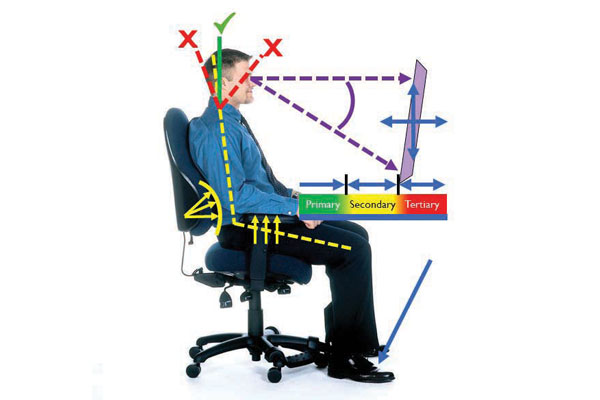Labs’ ergonomics team encourages online self-assessments to help employees adjust to remote work
See below: Tips for an ergonomic home workstation
With a record number of Sandia’s workforce now working from home during the COVID-19 pandemic, the Labs’ ergonomic team has helped make the transition to a home office safe for employees.
Lance Perry, ergonomics program lead, said the team “is actively involved with helping the Sandia workforce in many ways through the application of the science of ergonomics. Our staff of four ergonomics professionals are fully engaged on a daily basis with educating, training and assisting the workforce through the proven principles of ergonomics and the effects these principles have on the health, safety and performance of the workforce.”
In late March, the New Mexico ergonomics team began a series of weekly Skype meetings to give employees tips and resources for remote work. They also are available for one-on-one virtual meetings to discuss the ergonomics of working from home. After the stay-at-home order was issued in New Mexico, the team acted quickly, immediately enabling the one-on-one meetings.
All employees who telecommute as part of their normal work schedule are encouraged to complete an ergonomic self-assessment online, said Environment, Safety and Health Director Johnathon Huff.
The ergonomic specialists also made a video available to the workforce, as well as presentations for individual departments on request.
Common injuries
Lance said common injuries sustained by employees at their workstation, whether at home or in an office or industrial setting, include cuts, bruises, scrapes and burns as well as slips, trips and falls. For office and remote workers, musculoskeletal illnesses become prominent. Understanding causal risks for these injuries, and helping employees modify their behaviors and redesign their work and workspace is important to reducing the risk of developing these maladies, he said.
In addition to helping employees avoid injuries, the team also strives to improve employees’ work performance through the science of ergonomics.
“Optimum performance is the goal of most organizations,” Lance said. “Removing the obstacles that contribute to suboptimum performance always makes good business sense. Our ergonomists are here to help our business lines achieve their business goals. Designing the workplace, tools and work practices to eliminate waste, inefficiencies and stressors, and to maximize performance, output and outcomes are the keys to success. Remember, ‘What beats your people beats your performance.’”
Optimizing work, prevention
California’s ergonomics specialists also have been helping telecommuters and the on-site workforce set up and maintain optimal workspaces. They offer “Ergo Tips and Resources” and “Healthy Habits – Healthy Spine” sessions over Skype, said Janet Nevarez, the site’s ergonomics subject matter expert.
Almost 500 employees have participated in the online sessions so far. The California team also continues to offer in-person evaluations. The most common issues the team has seen include employees experiencing strain from frequently reaching for a mouse or keyboard, or not using an external mouse or keyboard with their laptop.
Jeff Duncan, the site’s physical therapist, also performs “symptomatic” evaluations for employees who are experiencing ergonomic-related physical issues, when referred by Health Services personnel.
“Being proactive by completing the online self-assessment and/or a virtual evaluation is your first line of defense. Prevention is the key. Your Ergonomics Program provides ergonomic support and services to help optimize employee safety and comfort, with the ultimate goal of reducing the likelihood and severity of ergonomic-related discomfort and/or injuries,” Janet said.
Mitigating the changing dynamic
When teleworking ramped up in response to the pandemic, leadership observed an uptick in ergonomic injuries. Johnathon and California Site Operations Director Pam McKeever discussed mitigations and agreed one of the most important steps was to encourage self-assessments for those working from home to ensure their safety.
When new workers start at Sandia or when a worker moves to a different office, Johnathon said, they automatically are contacted and encouraged to complete an online evaluation, which results in very few ergonomic injuries Labs-wide. Now, with so many working remotely, that dynamic has changed.
At the beginning of June, employees at the Labs’ California site who do any work from home were required to complete an online ergonomic self-assessment to evaluate their workstation and injury risk. Employees in Sandia’s Environment, Safety & Health organization also have been asked to complete an assessment, and leaders in other areas are encouraging employees to complete an assessment as well.
“Many simple adjustments can be made to a person’s home workspace, such as sitting on a pillow or rolling up a towel as a wrist rest. Using the RSIGuard software for reminders also can help. For ES&H and California Site Operations, these strategies are making a difference,” Pam said.
Numerous resources for creating an ergonomic workstation and lowering injury risk, including the self-assessment tool, are available to the workforce at the Sandia Ergonomics website, ergozone.sandia.gov.
Tips for an ergonomic home workstation

- Use an external keyboard and mouse with your laptop.
- Attach a stand-alone monitor to your laptop.
- Take frequent breaks; get up from your desk and stretch about 10 minutes for every hour or five minutes every half hour.
- Use a headset for phone calls and videoconferences.
- Consider scheduling shorter meetings (e.g., 50-55 minutes instead of an hour) to allow participants a stretch break afterward.
- Install the RSIGuard software for break reminders and stretching exercises.
- Sit in a supported, optimum seated posture and organize your desk to reduce reach (see image, left).